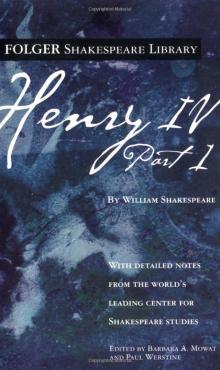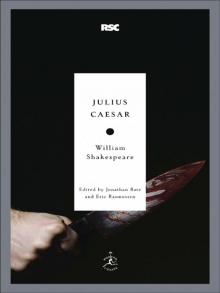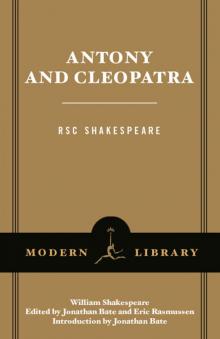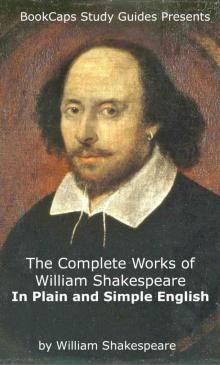- Home
- William Shakespeare
Richard III
Richard III Read online
The RSC Shakespeare
Edited by Jonathan Bate and Eric Rasmussen
Chief Associate Editor: Héloïse Sénéchal
Associate Editors: Trey Jansen, Eleanor Lowe, Lucy Munro, Dee Anna
Phares, Jan Sewell
Richard III
Textual editing: Eric Rasmussen
Introduction and Shakespeare’s Career in the Theater: Jonathan Bate
Commentary: Charlotte Scott and Héloïse Sénéchal
Scene-by-Scene Analysis: Esme Miskimmin
In Performance: Karin Brown (RSC stagings), and Jan Sewell (overview)
Actor, Director, and Designer (interviews by Jonathan Bate and Kevin Wright): Simon Russell Beale, Bill Alexander, and Tom Piper
Reflections: Richard Eyre
Editorial Advisory Board
Gregory Doran, Chief Associate Director,
Royal Shakespeare Company
Jim Davis, Professor of Theatre Studies, University of Warwick, UK
Charles Edelman, Senior Lecturer, Edith Cowan University,
Western Australia
Lukas Erne, Professor of Modern English Literature,
Universite de Geneve, Switzerland
Maria Evans, Director of Education, Royal Shakespeare Company
Akiko Kusunoki, Tokyo Woman’s Christian University, Japan
Ron Rosenbaum, author and journalist, New York, USA
James Shapiro, Professor of English and Comparative Literature,
Columbia University, USA
Tiffany Stern, Fellow and Tutor in English, University of Oxford, UK
2008 Modern Library Paperback Edition
Copyright © 2008 by The Royal Shakespeare Company
All rights reserved.
Published in the United States by Modern Library, an imprint of
The Random House Publishing Group, a division of Random House, Inc.,
New York.
MODERN LIBRARY and the TORCHBEARER Design are registered trademarks
of Random House, Inc.
“Royal Shakespeare Company,” “RSC,” and the RSC logo are trademarks
or registered trademarks of The Royal Shakespeare Company.
eISBN: 978-1-58836-830-0
www.modernlibrary.com
v3.1
CONTENTS
Cover
Title Page
Copyright
Introduction
The Cycle of History
Richard the Player
Beyond Marlowe
About the Text
Key Facts
The Tragedy of Richard the Third
List of Parts
Act 1
Scene 1
Scene 2
Scene 3
Scene 4
Act 2
Scene 1
Scene 2
Scene 3
Scene 4
Act 3
Scene 1
Scene 2
Scene 3
Scene 4
Scene 5
Scene 6
Scene 7
Act 4
Scene 1
Scene 2
Scene 3
Scene 4
Scene 5
Act 5
Scene 1
Scene 2
Scene 3
Textual Notes
Quarto Passages That Do Not Appear in the Folio
Scene-by-Scene Analysis
Richard III in Performance:
The RSC and Beyond
Four Centuries of Richard III: An Overview
At the RSC
Actor, Director, and Designer: Interviews with
Simon Russell Beale, Bill Alexander, and Tom Piper
Richard and Tyranny: Reflections by Richard Eyre
Shakespeare’s Career in the Theater
Beginnings
Playhouses
The Ensemble at Work
The King’s Man
Shakespeare’s Works: A Chronology
Kings and Queens of England: From the History
Plays to Shakespeare’s Lifetime
The History Behind the Histories: A Chronology
Further Reading and Viewing
References
Acknowledgments and Picture Credits
INTRODUCTION
THE CYCLE OF HISTORY
Shakespeare’s first group of historical plays comes to a harmonious conclusion with the defeat of wicked King Richard at the battle of Bosworth Field in 1485. The victorious Henry, Earl of Richmond, belongs to the House of Lancaster. He marries the Princess Elizabeth, of the House of York, thus unifying the nobility and bringing to an end the Wars of the Roses. In the final scene of Richard the Third, the Lord Stanley, Earl of Derby, places the crown on Richmond’s head and he becomes King Henry VII, inaugurator of the Tudor dynasty. The play closes with a speech in which Henry looks back on the civil strife that has been the subject not just of this play but also of the Henry the Sixth sequence. It also looks forward to the golden age over which his wife’s namesake, Queen Elizabeth, liked to believe that she reigned:
England hath long been mad, and scarred herself;
The brother blindly shed the brother’s blood,
The father rashly slaughtered his own son,
The son, compelled, been butcher to the sire:
All this divided York and Lancaster,
Divided in their dire division.
O, now let Richmond and Elizabeth,
The true succeeders of each royal house,
By God’s fair ordinance conjoin together.
And let thy heirs—God, if thy will be so—
Enrich the time to come with smooth-faced peace,
With smiling plenty and fair prosperous days!
On hearing these lines, Shakespeare’s audience would themselves have looked both forward and back: back to a bloody period in the nation’s history, with relief at how it was providentially ended by the Tudor dispensation; forward to an uncertain future, in the knowledge that the queen was now too old to sustain the line.
Historians still debate the question of how villainous Richard III really was, and in particular whether he personally ordered the slaying of the princes in the Tower. What is not in doubt is that it was convenient for the Tudors to paint him as a villain, in order to make his opponent, the future Henry VII, into a hero and a saint. Sir Thomas More played a major part in the process with his History of King Richard III, written at the court of Richmond’s son, Henry VIII. Shakespeare finished the work in the public theater of Henry VIII’s younger daughter, immortalizing Richard as the scheming Crookback. The English are notorious for getting their theology from Milton and their history from Shakespeare, rather than from more orthodox sources. The endurance of the image of a Richard who is “determinèd to prove a villain” is proof of the power of drama to be more memorable than written history. Richard the Third is one of those core Shakespearean plays that everybody has heard of, even if they have never read it. The success of two film versions—first Sir Laurence Olivier’s and subsequently Sir Ian McKellen’s dazzling update to the fascist 1930s—has assured its continuing life.
As in the Henry the Sixth plays, the language is frequently elevated and highly rhetorical. The combination of formal language and a sense of symmetry in the events—action leading to reaction, bloody violence to revenge, a slippery rise followed by a crashing fall as the wheel of fortune turns—places the play in the tradition of the Roman tragedian Seneca. The influence on Shakespeare was probably both direct—Seneca had been published in English translation in the 1580s—and indirect, via the multiauthored Mirror for Magistrates, a highly Senecan collection of “complaint” poems, telling of misfortunes and wickedness, written in the voices of the vi
ctims of history, including both King Richard’s brother George, Duke of Clarence, and King Edward IV’s mistress, Jane Shore.
The Senecan symmetry is taken to an extreme in the role of Queen Margaret, the widow of King Henry VI, who had been such a powerful force throughout the Wars of the Roses plays. In Act 1 Scene 3, she formally curses Rivers, Dorset, Hastings, Buckingham, and Richard himself. All her curses are fulfilled and as each character dies, Richard realizes that this is the case. Senecan tragedy traditionally began with a ghost returning from the underworld and demanding revenge for his or her murder. In an elegant variation, Shakespeare withholds the ghosts for the climax of the play, bringing them on to taunt King Richard in his tent on the eve of the battle that will be his downfall. The scene in which Richard confronts those ghosts would duly become one of the great set pieces of the English stage: this was the play, and the moment within the play, chosen in the eighteenth century by the actor David Garrick and the painter William Hogarth for the portrait that immortalized Garrick and showed that Shakespeare was a fit subject for art of high moral and historical seriousness.
1. Engraving after William Hogarth’s 1745 portrait of the actor David Garrick as Richard facing the ghosts on the night before the battle of Bosworth Field. Executed in the artist’s studio, but influenced by the elaborate stage design of the period, this painting inaugurated the tradition of representing great moments in Shakespeare in the style of “history painting” that had hitherto been reserved for elevated biblical and classical stories. The original portrait is in the Walker Art Gallery, Liverpool.
RICHARD THE PLAYER
Whereas nearly everybody in the Henry the Sixth plays appears to be caught up in a maelstrom of historical events that they are not able to control, Richard attempts to take command of his own and his country’s destiny. There is little doubt that the part was written for Richard Burbage, just as he was becoming Shakespeare’s closest friend in the theater world. Richard the Third is the first of the small group of Shakespearean plays that are not ensemble pieces—as the Henry the Sixth plays so clearly were—but star vehicles, in which the leading player has three times as many lines as anybody else. This play was the making of both the writer and the star. It accounts for their nicknames in a well-attested theatrical anecdote that has them as rivals in the bed of a theater-crazed citizen’s wife: Burbage is “Richard the Third” and Shakespeare “William the Conqueror.”
The trick that they seem to have worked out together was to make the leading character into the apparent author of his own script. From the very opening soliloquy, Richard takes the audience into his confidence and shares with them the role he will adopt and the plot of the drama that he intends to act out, which might be entitled “an unlovely but clever man plans his ascent to the throne, not letting anybody—even an innocent child—get in his way.” He is master of the wink and the aside; he rejoices in playing the role of Iniquity, the Vice in the old tradition of morality plays. The audience enjoys his performance exactly because they know it is a performance.
The master actor needs a “straight man.” For Richard, this role is played by Buckingham, who assists him as he stage-manages his public image for his appearance before the Lord Mayor and citizens of London:
Enter Richard aloft, between two Bishops
MAYOR See, where his grace stands ’tween two clergymen.
BUCKINGHAM Two props of virtue for a Christian prince,
To stay him from the fall of vanity:
And, see, a book of prayer in his hand,
True ornaments to know a holy man.—
Famous Plantagenet, most gracious prince,
Lend favourable ear to our requests,
And pardon us the interruption
Of thy devotion and right Christian zeal.
In the previous play in the sequence, Henry VI’s prayer-book was a sign that he did not want to be king. Richard’s is a sign that he is pretending not to want to be king, thus leading the Londoners to beg him to take on the office. “Will you enforce me to a world of cares?” he says, feigning reluctance—and in the next breath he whispers, “Call them again,” ensuring that the offer is renewed so that this time it can be accepted. In all this, he is, as always, the consummate actor.
There are two key turning points for Richard. One is when he contrives to lose his right-hand man, Buckingham. The comedian begins to flounder without his stooge. The other is when the lamenting women who serve as a kind of Greek chorus to the action come together and confront him in the enormously long fourth scene of the fourth act. Richard’s bravura seduction of the Lady Anne had revealed his skill with words, but now his verbal power is matched by the combined forces of Queen Margaret and Queen Elizabeth. If one innovation in the writing of Richard the Third was the conversion of the ensemble chronicle play into a star vehicle for a single huge theatrical personality, the other was the feminization of this traditionally masculine form. In Shakespeare’s earlier history plays, in those of other authors, and indeed in the tragedies of Marlowe, women are bit-part players. Here, however, the boy-actors who play Elizabeth, Margaret, and Anne are given larger parts and more richly inflected rhetoric than all of their adult colleagues save the leading three who play Richard, Buckingham, and Clarence. Symbolically, given that Richard explains his own lust for power as a consequence of his inadequacy in the arts of love, it is fitting that he meets his match in the form of women and boys.
It is Richard’s theatrical self-consciousness that ultimately sets his play above the three parts of Henry the Sixth. In The First Part of Henry the Sixth, Talbot is a manly hero and Joan an intriguing semi-comic villain; in The Second Part, there is splendid energy (Queen Margaret running amok) and variety (Jack Cade and the voice of the discontented commons); in The Third Part, we witness a scene of high drama when York is taunted with a paper crown before being stabbed to death. But it is not until Richard of Gloucester gets into his stride that we meet a figure with the compelling theatrical presence of a Falstaff or an Iago. At the climax of his first long soliloquy in Act 3 of The Third Part of Henry the Sixth—a speech that the theatrical tradition has often imported into Richard the Third—he announces that he will “play the orator,” “add colors to the chameleon,” and “change shapes with Proteus for advantages.” Each image is of the art of the actor, with his persuasive tongue and power of self-transformation.
BEYOND MARLOWE
Richard adds that he will “set the murderous Machevil to school.” In his black farce The Jew of Malta, Christopher Marlowe had brought on a representation of Machiavelli, the Renaissance archetype of the scheming politician, to speak the prologue. As soon as the Prologue leaves the stage, Barabas the Jew is revealed, speaking his opening soliloquy. The audience thus makes the equation that Barabas is a Machiavellian schemer. In Richard the Third, Shakespeare made a bold advance on this device. He dispensed with a prologue and began the action with Richard’s riveting soliloquy, “Now is the winter of our discontent.” Where Marlowe had cast Barabas in the role of the machiavel by means of a pointed structural device, Shakespeare’s Richard casts himself. He announces that since his crookback prevents him from playing the role of a stage lover, he will self-consciously adopt that of a stage villain. For good measure, he goes on in the second scene to show that he can in fact play the lover—with such accomplishment that he successfully woos Lady Anne over the very corpse of her father-in-law when she knows that he has been responsible for the murder of her first husband. As promised, he plays the orator to supreme effect. By the third act, he is changing shapes with Proteus and, as we have seen, appearing between two bishops in the color of a holy man. By means of the orator’s art of saying the opposite of what he means—“I cannot, nor I will not” accept the crown—he wins over the Mayor and the citizens of London.
The character of Richard III is Shakespeare’s overstepping of the Marlovian antihero. Marlowe’s Tamburlaine, Barabas, and Dr. Faus
tus fashion their identities by assuming roles—scourge of God, machiavel, conjuror. They do not stop to think that such roles are precisely that: flimsy theatrical impersonations. If they did stop, the whole Marlovian house of cards would come tumbling down. But Shakespeare began from a different place. He was an actor himself. This was the one trump card that was unavailable to Marlowe. Richard is quintessentially Shakespearean, supremely charismatic in the theater, because he knows that he is a role-player. He revels, and makes the audience revel, in playacting. He is the first full embodiment of a Shakespearean obsession that culminates in Macbeth’s “poor player” and Prospero’s “These our actors.” It is Iago in Othello who says, “I am not what I am.” But Richard could have said it too. And, as the critic Lionel Trilling remarked in a study of Sincerity and Authenticity (1972), so could almost every one of Shakespeare’s most memorable characters: Hamlet has no sooner heard out the Ghost than he resolves to be what he is not, a madman. Rosalind in As You Like It is not a boy, Portia in The Merchant of Venice is not a doctor of law, Romeo’s beloved Juliet is not a corpse, in Measure for Measure the Duke is not a friar and Mariana is not Isabella (nor is Helen Diana in All’s Well That Ends Well), Edgar in King Lear is not Tom o’ Bedlam, Hermione in The Winter’s Tale is neither dead nor a statue.
Marlowe’s characters invest everything in their aspirations. Shakespeare’s are more flexible. They are not what they are. That is surely because Shakespeare was an actor and Marlowe was not. It is also one reason why Shakespeare’s characters have a richer, more varied and continuous stage afterlife than Marlowe’s. Only in his dreams does Richard stop acting. And when that happens, his identity collapses:
Cold fearful drops stand on my trembling flesh.
What? Do I fear myself? There’s none else by.
Richard loves Richard: that is, I am I.
Is there a murderer here? No. Yes, I am.
Then fly. What, from myself? Great reason why:
Lest I revenge. What? Myself upon myself?
Alack, I love myself. Wherefore? For any good

 Romeo and Juliet
Romeo and Juliet As You Like It (Folger Shakespeare Library)
As You Like It (Folger Shakespeare Library) Hamlet
Hamlet Richard II (Folger Shakespeare Library)
Richard II (Folger Shakespeare Library) Macbeth
Macbeth Henry V
Henry V The Winter's Tale
The Winter's Tale The Taming of the Shrew
The Taming of the Shrew The Comedy of Errors
The Comedy of Errors King Lear (Folger Shakespeare Library)
King Lear (Folger Shakespeare Library) Twelfth Night
Twelfth Night Othello
Othello The Two Gentlemen of Verona
The Two Gentlemen of Verona Henry IV, Part 1 (Folger Shakespeare Library)
Henry IV, Part 1 (Folger Shakespeare Library) King John/Henry VIII (Signet Classics)
King John/Henry VIII (Signet Classics) The Tempest
The Tempest Titus Andronicus (Dover Publications)
Titus Andronicus (Dover Publications) A Midsummer Night's Dream
A Midsummer Night's Dream Antony and Cleopatra (Arden Shakespeare: Third Series)
Antony and Cleopatra (Arden Shakespeare: Third Series) The Oxford Shakespeare: Henry IV, Part 2 (Oxford World's Classics)
The Oxford Shakespeare: Henry IV, Part 2 (Oxford World's Classics) Much Ado About Nothing (Arden Shakespeare: Third Series)
Much Ado About Nothing (Arden Shakespeare: Third Series) All's Well That Ends Well
All's Well That Ends Well Titus Andronicus & Timon of Athens
Titus Andronicus & Timon of Athens Richard III (Modern Library Classics)
Richard III (Modern Library Classics) Coriolanus
Coriolanus srsly Hamlet (OMG Shakespeare)
srsly Hamlet (OMG Shakespeare) The Merchant of Venice
The Merchant of Venice Richard III
Richard III Richard II
Richard II Pericles
Pericles As You Like It
As You Like It Cymbeline
Cymbeline Alls Wel that ends Well
Alls Wel that ends Well YOLO Juliet
YOLO Juliet A Midsummer Night #nofilter
A Midsummer Night #nofilter Love's Labour's Lost
Love's Labour's Lost Much Ado About Nothing
Much Ado About Nothing Romeo & Juliet & Vampires
Romeo & Juliet & Vampires The Arden Shakespeare Complete Works
The Arden Shakespeare Complete Works Julius Caesar
Julius Caesar Five Revenge Tragedies: The Spanish Tragedy, Hamlet, Antonio's Revenge, The Tragedy of Hoffman, The Revenger's Tragedy (Penguin Classics)
Five Revenge Tragedies: The Spanish Tragedy, Hamlet, Antonio's Revenge, The Tragedy of Hoffman, The Revenger's Tragedy (Penguin Classics) Macbeth #killingit
Macbeth #killingit The Oxford Shakespeare: The Complete Works
The Oxford Shakespeare: The Complete Works Hamlet, Prince of Denmark (Collins edition)
Hamlet, Prince of Denmark (Collins edition) King John & Henry VIII
King John & Henry VIII Henry IV, Part 2
Henry IV, Part 2 Complete Plays, The
Complete Plays, The The Sonnets and Other Poems
The Sonnets and Other Poems Antony and Cleopatra
Antony and Cleopatra Henry IV, Part 1
Henry IV, Part 1 Is This a Dagger Which I See Before Me?
Is This a Dagger Which I See Before Me? The Complete Works of William Shakespeare In Plain and Simple English (Translated)
The Complete Works of William Shakespeare In Plain and Simple English (Translated) The Sonnets
The Sonnets